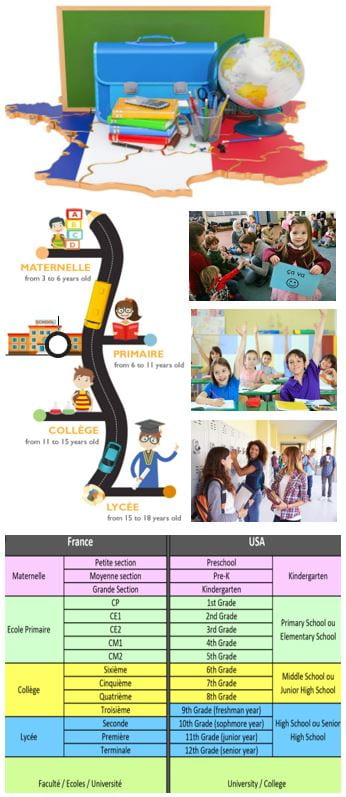Understanding French Schools: La Rentrée to Le Bac

With all of the recent Back to School (La Rentrée) activities kicking off the new school year, you may be wondering about how the
French education system works. The
school system in France can be a bit of a puzzle for outsiders. Not only are the years in secondary school counted backwards but they are
also referred to as collège (middle school) and lycée (high school). Compulsory education begins at age six, with école
primaire
(elementary school) however école maternelle (nursery school) is available to parents choosing to start their child at school at
age three. The chart at left provides an easy reference for the various grade level terms and equivalents used in France and the US.
As in many countries, a variety of educational options is available for school-aged children in France, including public, private, and parochial schools. Public education is state-funded and available to all residents. Education is centralized with its programs regulated by Le Ministre de l'Éducation nationale (Ministry of Education), which determines common curricular components. State support for education is written into the French Constitution : “l’organisation de l’enseignement public obligatoire gratuit et laïque à tous degrés est un devoir de l’État”.
L’école maternelle prepares young children for future school life learning basic numeracy and literacy, as well as life skills such as teamwork, respect for others and imagination. L’école primaire is the next stage of education in France teaching lessons in grammar, literature, history, geography, mathematics, science, civics, arts, music, and foreign language. L’école secondaire begins with le collège, designed to provide fundamental education before students begin to specialize at le lycée, making it a cornerstone of French education. Le collège offers courses in French grammar and literature, history, geography, foreign language, music, arts, mathematics, technology, civics, chemistry, physics, and biology. At the end of the fourth year, students take a national examination called le brevet des collèges to prove they are ready to transition into le lycée. Students in France have the option of attending a lycée classique, or lycée général, which offers general studies, or else a lycée professionnel or lycée des métiers, which focuses on technical training. Le baccalauréat, or bac, is a written examination that students take to graduate from their lycée.
French students can then go for les études supérieures (higher studies) à l’université ("la fac") or in les Grandes Écoles (distinguished schools). You need to have le baccalauréat to get into these schools, and Les Grandes Écoles often require that you have “une mention” (honors) to get in. This informative blog provides some great vocabulary terms to master when discussing les écoles françaises, or check out this fun blog to meet an American who was a student teacher in France and shares some of her interesting experiences with the different systems of education. Bon apprentissage des écoles françaises!
Design by Monsieur Graphic
